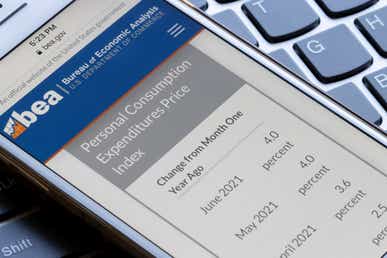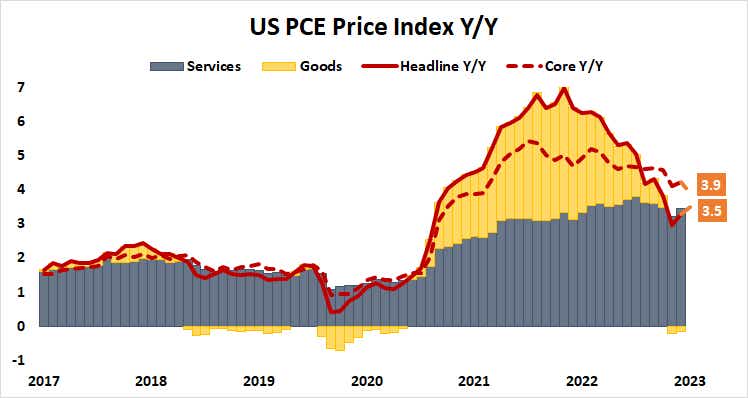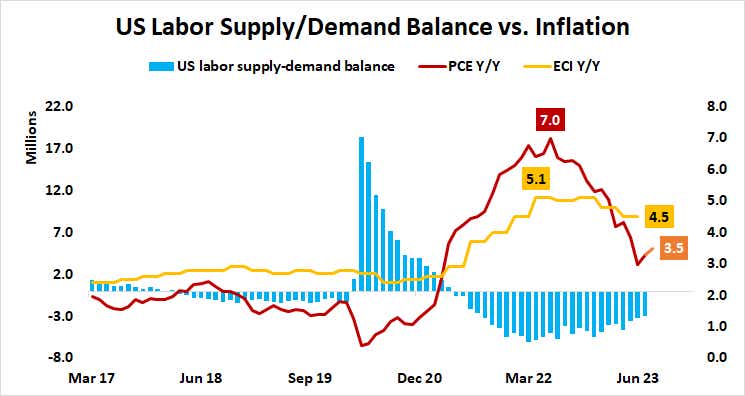Private Consumption Expenditure (PCE) Release Preview: Are Stocks at Risk?

Private Consumption Expenditure (PCE) Release Preview: Are Stocks at Risk?
By:Ilya Spivak
Stocks won’t like it as the Fed’s favored PCE gauge of U.S. inflation signals a “higher for longer” path for interest rates
- Incoming U.S. PCE inflation data is unlikely to change “higher for longer” Fed stance.
- The central bank still looks to unstick labor-driven services costs by squeezing growth.
- Stocks are likely to fall further as longer-dated Treasury yields and the U.S. dollar rise.
The latest update of U.S. inflation data is likely to leave the outlook for Federal Reserve monetary policy broadly unchanged. That’s probably unwelcome news for stock markets.
The Fed’s favored private consumption expenditure (PCE) price growth gauge is expected to show that price growth accelerated for a second consecutive month in August, ticking higher from 3.3% to 3.5% year over year. The so-called “core” PCE index, which excludes volatile food and energy prices, is seen slowing from 4.2% to 3.9%.
These outcomes look set to echo analog consumer price index (CPI) data published two weeks ago. Those figures revealed rising oil prices as the source of the disconnect, as expected. There isn’t much that the US central bank can do with monetary policy to address that issue in a targeted way, so its focus is likely to remain on the service sector.

Looking under the hood, the cost of housing is the main driver of services prices. Here too, the Fed has relatively little agency to influence near-term outcomes. Its own rate hike cycle has translated into illiquidity because mortgage rates offered in the market exceed those locked in by owners by close to 400 basis points (bps) on average. That has discouraged sellers, drawing down inventories and underpinning prices.
The Fed inflation-fighting effort is aimed at the labor market
That leaves the labor market. Employment costs have proven to be stickier than overall inflation because lingering labor shortages have underpinned wages. The U.S. central bank hopes to use higher borrowing costs to cool economic activity, reduce labor demand and trigger a wave of wage agreement resets (i.e., layoffs). It hopes to dial in just enough pain for this process to pass through the economy without too much damage, the much-hoped-for “soft landing”.
With core inflation inching lower and purchasing managers index (PMI) data suggesting economic activity has already slowed to near standstill, the central bank has opted to sit on its hands for now. It intends to wait for the cumulative effects of prior tightening to build.

How long the Fed plans to keep at this has become the main object of speculation for financial markets. The first 25 bps reduction is expected by July, and another has been penciled in by November 2024. The likelihood of a third one before the calendar turns to 2025 is estimated at 60%. On balance, this means markets lean toward 75bps in rate cuts next year.
Sticky inflation begets sticky interest rates, menacing markets
That marks a contrast with the Fed’s own reckoning. The markets’ prognosticating shakes out to a Fed Funds rate at 4.6-4.7% by the end of 2024. Officials on the Fed’s policy-setting FOMC committee set their median estimate at 5.1% in the latest forecast update released last week.
This “higher for longer” signal has spooked markets. They reacted by driving up longer-term Treasury bond yields, lifting the US dollar, and sinking stocks. Fed Chair Jerome Powell and company are unlikely to change their tune without an improbably larger-than-expected core PCE drop. That signals more of the same is likely to be ahead.
Ilya Spivak, tastylive head of global macro, has 15 years of experience in trading strategy, and he specializes in identifying thematic moves in currencies, commodities, interest rates and equities. He hosts Macro Money and co-hosts Overtime, Monday-Thursday. @Ilyaspivak
For live daily programming, market news and commentary, visit tastylive or the YouTube channels tastylive (for options traders), and tastyliveTrending for stocks, futures, forex & macro.
Trade with a better broker, open a tastytrade account today. tastylive, Inc. and tastytrade, Inc. are separate but affiliated companies.
Options involve risk and are not suitable for all investors. Please read Characteristics and Risks of Standardized Options before deciding to invest in options.
tastylive content is created, produced, and provided solely by tastylive, Inc. (“tastylive”) and is for informational and educational purposes only. It is not, nor is it intended to be, trading or investment advice or a recommendation that any security, futures contract, digital asset, other product, transaction, or investment strategy is suitable for any person. Trading securities, futures products, and digital assets involve risk and may result in a loss greater than the original amount invested. tastylive, through its content, financial programming or otherwise, does not provide investment or financial advice or make investment recommendations. Investment information provided may not be appropriate for all investors and is provided without respect to individual investor financial sophistication, financial situation, investing time horizon or risk tolerance. tastylive is not in the business of transacting securities trades, nor does it direct client commodity accounts or give commodity trading advice tailored to any particular client’s situation or investment objectives. Supporting documentation for any claims (including claims made on behalf of options programs), comparisons, statistics, or other technical data, if applicable, will be supplied upon request. tastylive is not a licensed financial adviser, registered investment adviser, or a registered broker-dealer. Options, futures, and futures options are not suitable for all investors. Prior to trading securities, options, futures, or futures options, please read the applicable risk disclosures, including, but not limited to, the Characteristics and Risks of Standardized Options Disclosure and the Futures and Exchange-Traded Options Risk Disclosure found on tastytrade.com/disclosures.
tastytrade, Inc. ("tastytrade”) is a registered broker-dealer and member of FINRA, NFA, and SIPC. tastytrade was previously known as tastyworks, Inc. (“tastyworks”). tastytrade offers self-directed brokerage accounts to its customers. tastytrade does not give financial or trading advice, nor does it make investment recommendations. You alone are responsible for making your investment and trading decisions and for evaluating the merits and risks associated with the use of tastytrade’s systems, services or products. tastytrade is a wholly-owned subsidiary of tastylive, Inc.
tastytrade has entered into a Marketing Agreement with tastylive (“Marketing Agent”) whereby tastytrade pays compensation to Marketing Agent to recommend tastytrade’s brokerage services. The existence of this Marketing Agreement should not be deemed as an endorsement or recommendation of Marketing Agent by tastytrade. tastytrade and Marketing Agent are separate entities with their own products and services. tastylive is the parent company of tastytrade.
tastyfx, LLC (“tastyfx”) is a Commodity Futures Trading Commission (“CFTC”) registered Retail Foreign Exchange Dealer (RFED) and Introducing Broker (IB) and Forex Dealer Member (FDM) of the National Futures Association (“NFA”) (NFA ID 0509630). Leveraged trading in foreign currency or off-exchange products on margin carries significant risk and may not be suitable for all investors. We advise you to carefully consider whether trading is appropriate for you based on your personal circumstances as you may lose more than you invest.
tastycrypto is provided solely by tasty Software Solutions, LLC. tasty Software Solutions, LLC is a separate but affiliate company of tastylive, Inc. Neither tastylive nor any of its affiliates are responsible for the products or services provided by tasty Software Solutions, LLC. Cryptocurrency trading is not suitable for all investors due to the number of risks involved. The value of any cryptocurrency, including digital assets pegged to fiat currency, commodities, or any other asset, may go to zero.
© copyright 2013 - 2025 tastylive, Inc. All Rights Reserved. Applicable portions of the Terms of Use on tastylive.com apply. Reproduction, adaptation, distribution, public display, exhibition for profit, or storage in any electronic storage media in whole or in part is prohibited under penalty of law, provided that you may download tastylive’s podcasts as necessary to view for personal use. tastylive was previously known as tastytrade, Inc. tastylive is a trademark/servicemark owned by tastylive, Inc.